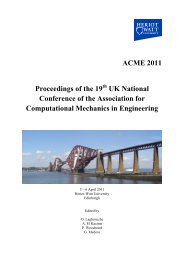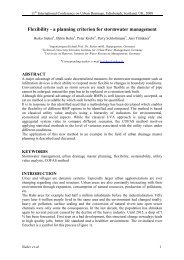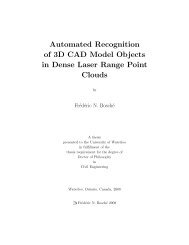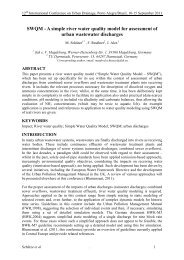Behaviour of ballasted track during high speed train passage
Behaviour of ballasted track during high speed train passage
Behaviour of ballasted track during high speed train passage
You also want an ePaper? Increase the reach of your titles
YUMPU automatically turns print PDFs into web optimized ePapers that Google loves.
<strong>Behaviour</strong> <strong>of</strong> <strong>ballasted</strong><br />
<strong>track</strong> <strong>during</strong> <strong>high</strong> <strong>speed</strong><br />
<strong>train</strong> <strong>passage</strong><br />
William Powrie and Jeffrey Priest<br />
University <strong>of</strong> Southampton<br />
High Speed Track<br />
Railways Day - 15 February 2011
Outline <strong>of</strong> talk<br />
• Background and Aims<br />
• Sub-base issues: effect <strong>of</strong> <strong>train</strong> <strong>speed</strong> on<br />
vertical <strong>track</strong> movements <strong>during</strong> <strong>train</strong><br />
<strong>passage</strong><br />
- numerical analysis<br />
- field monitoring<br />
• Ballast issues<br />
- ballast migration<br />
- flying ballast<br />
•Conclusions<br />
High Speed Track<br />
Railways Day - 15 February 2011
Background and<br />
Aims<br />
High Speed Track<br />
Railways Day - 15 February 2011
Background<br />
• Increased <strong>train</strong> <strong>speed</strong>s on both new and classic railway<br />
lines<br />
• Lack <strong>of</strong> detailed analytical understanding <strong>of</strong> <strong>track</strong> system<br />
/ sub-soil behaviour, even for traditional <strong>speed</strong> railways<br />
• Not sure how well past experience and observation<br />
(empiricism) will extrapolate to <strong>high</strong>er <strong>speed</strong> lines<br />
• Application <strong>of</strong> recent advances in soil mechanics and<br />
instrumentation ⇒ improved understanding <strong>of</strong> ballast<br />
and sub-base performance ⇒ better whole life cost<br />
modelling<br />
• Is <strong>ballasted</strong> <strong>track</strong> the best choice for <strong>high</strong> <strong>speed</strong> rail?<br />
High Speed Track<br />
Railways Day - 15 February 2011
Aims<br />
• To assess the effects <strong>of</strong> <strong>train</strong> <strong>speed</strong> on the<br />
load/deformation response <strong>of</strong> the <strong>track</strong><br />
foundation, by analysis and field<br />
measurements<br />
• To investigate some additional problems<br />
associated with the use <strong>of</strong> <strong>ballasted</strong> <strong>track</strong><br />
for <strong>high</strong> <strong>speed</strong> railway lines<br />
High Speed Track<br />
Railways Day - 15 February 2011
Numerical modelling <strong>of</strong><br />
<strong>track</strong>-bed displacements<br />
Effect <strong>of</strong> <strong>train</strong> <strong>speed</strong><br />
High Speed Track<br />
Railways Day - 15 February 2011
Method<br />
• Dynamic, 2D finite element analysis using<br />
ABAQUS<br />
• Elastic, undrained response<br />
• Interpretation in terms <strong>of</strong> total stresses<br />
• Loading magnitude and geometry based on<br />
Spoornet COALlink line (“Cape” gauge, 1067 mm)<br />
• 130 kN maximum wheel load<br />
• Analysis modelled the vertical centre plane along<br />
the <strong>track</strong>, and <strong>passage</strong> <strong>of</strong> a three-wagon <strong>train</strong><br />
• Model validated with reference to field data<br />
High Speed Track<br />
Railways Day - 15 February 2011
2D dynamic FE mesh<br />
Sleeper 0.2<br />
Ballast<br />
SSB<br />
SB<br />
A<br />
B<br />
Natural ground<br />
0.3<br />
0.2<br />
0.2<br />
0.2<br />
0.2<br />
High Speed Track<br />
Railways Day - 15 February 2011<br />
Pad (0.01m thick) Rail<br />
V1 V2 V3 V4<br />
0.38<br />
109.2<br />
E1<br />
0.27<br />
E2<br />
E3<br />
31.51
Typical results: deflections<br />
High Speed Track<br />
Railways Day - 15 February 2011
Variation <strong>of</strong> maximum displacement<br />
with <strong>speed</strong><br />
High Speed Track<br />
Railways Day - 15 February 2011
Field monitoring:<br />
methods<br />
High Speed Track<br />
Railways Day - 15 February 2011
Measurement techniques: remote<br />
video monitoring<br />
High Speed Track<br />
Railways Day - 15 February 2011<br />
Webcam captures digital video images<br />
<strong>of</strong> a target, from which displacement is<br />
calculated using computer algorithm.<br />
Digital camera frame rate up to 170fps
Measurement techniques: geophones<br />
Geophones: LF24, 1 Hz natural frequency, logged at 500Hz<br />
Mounted on sleeper or positioned in borehole at different<br />
depths in the ground<br />
High Speed Track<br />
Railways Day - 15 February 2011
Geophone data<br />
Geophone produces a voltage proportional to velocity <strong>of</strong> the sensor (a). Knowing the response<br />
characteristics <strong>of</strong> the geophone the velocity can be computed (b). Integration <strong>of</strong> data leads to calculated<br />
displacement (c). Dominant axle and bogie frequencies can be obtained (d).<br />
High Speed Track<br />
Railways Day - 15 February 2011<br />
a<br />
c<br />
b<br />
d
Comparison: PIV and geophone data<br />
Displacement (mm)<br />
0.1<br />
0<br />
-0.1<br />
-0.2<br />
-0.3<br />
-0.4<br />
-0.5<br />
-0.6<br />
6 6.5 7 7.5 8<br />
Time (s)<br />
8.5 9 9.5 10<br />
High Speed Track<br />
Railways Day - 15 February 2011<br />
Geophone<br />
Video<br />
Geophones and<br />
PIV data are in<br />
agreement.<br />
Video frame rate<br />
<strong>of</strong> 30fps gives an<br />
image every<br />
880mm <strong>of</strong> travel<br />
compared with<br />
53mm for 500 Hz<br />
geophones. Both<br />
methods capture<br />
displacements due<br />
to individual axles.
Field monitoring:<br />
results<br />
What happens in reality?<br />
High Speed Track<br />
Railways Day - 15 February 2011
Effect <strong>of</strong> <strong>train</strong> <strong>speed</strong>: HS1<br />
• Standard gauge (1435 mm)<br />
• Same <strong>train</strong>s (Class 390 Eurostar sets)<br />
• Static axle load 15.36 tonne (wheel load ~ 75.3 kN)<br />
• Speeds ~ 120 km/hr and 270 km/hr<br />
High Speed Track<br />
Railways Day - 15 February 2011
Vertical displacement vs <strong>speed</strong><br />
for similar <strong>train</strong>s on HS1<br />
High Speed Track<br />
Railways Day - 15 February 2011
Calculate subgrade modulus from Beam on<br />
Elastic Foundation (BOEF) model<br />
High Speed Track<br />
Railways Day - 15 February 2011
Track modulus from sleeper displacements<br />
assuming a constant (static) axle load<br />
High Speed Track<br />
Railways Day - 15 February 2011
Track modulus vs displacement for all<br />
sleepers; <strong>track</strong> modulus assumed constant<br />
for an individual sleeper<br />
High Speed Track<br />
Railways Day - 15 February 2011
Trend lines for different <strong>speed</strong>s at<br />
constant modulus<br />
High Speed Track<br />
Railways Day - 15 February 2011
Increase in dynamic load with <strong>speed</strong><br />
• Dynamic FE analysis suggest that at o.5V c (<strong>train</strong><br />
<strong>speed</strong> = 400km/h) dynamic load increases by less<br />
than 10% <strong>of</strong> static, so at 260km/h dynamic load ≈<br />
static load<br />
• Field monitoring suggests dynamic load at<br />
260km/h is around 1.2 – 1.3 × static<br />
• At 260km/h, Li and Selig (1998) suggest dynamic<br />
load increases to around 2.45 × static<br />
High Speed Track<br />
Railways Day - 15 February 2011
Ballast issues (1)<br />
Ballast migration<br />
(ballast circles)<br />
High Speed Track<br />
Railways Day - 15 February 2011
High Speed Track<br />
Railways Day - 15 February 2011<br />
Ballast migration
Ballast migration investigation:<br />
instrument layout<br />
Vertical, lateral<br />
and longitudinal<br />
sleeper velocities<br />
measured using<br />
geophones<br />
High Speed Track<br />
Railways Day - 15 February 2011
Measured sleeper displacements<br />
Vertical displacement <strong>of</strong> <strong>high</strong> rail end <strong>of</strong> sleeper is<br />
about 2.2 times that <strong>of</strong> low rail end<br />
High Speed Track<br />
Railways Day - 15 February 2011
h<br />
Y e<br />
Q e<br />
α<br />
mv /R<br />
2<br />
s<br />
High Speed Track<br />
Railways Day - 15 February 2011<br />
mg<br />
mgsinα<br />
Y i<br />
Q i<br />
h c<br />
For a Pendolino<br />
traversing a curve<br />
<strong>of</strong> radius 1230m<br />
radius at<br />
180km/h, quasi<br />
static analysis<br />
gives Q e = 85.0 kN<br />
and Q i = 49.2 kN,<br />
i.e. a ratio <strong>of</strong> loads<br />
<strong>of</strong> 1.73
Train Run Inner rail<br />
δ mm<br />
High Speed Track<br />
Railways Day - 15 February 2011<br />
Outer rail<br />
δ mm<br />
Ratio<br />
δinner /δouter Ratio<br />
k outer<br />
/k inner<br />
1 0.390 0.853 2.19 1.27<br />
2 0.414 0.900<br />
2.17 1.25<br />
3 0.402 0.903 2.25 1.30<br />
4 0.387 0.908 2.35 1.36<br />
Ratio <strong>of</strong> deflections is greater than the ratio <strong>of</strong> quasi‐<br />
static loads implying difference in support stiffnesses
Dynamic analysis using Vampire gives a maximum value<br />
<strong>of</strong> Q e <strong>of</strong> >100kN and a load ratio <strong>of</strong> up to at least ~2.5<br />
High Speed Track<br />
Railways Day - 15 February 2011
Proposed mechanism<br />
During loading sleeper rotates about the low rail end and<br />
moves towards the <strong>high</strong> rail end. Due to shape <strong>of</strong> sleeper<br />
ballast falls vertically <strong>during</strong> loading and is pushed up (down<br />
slope) <strong>during</strong> unloading.<br />
High Speed Track<br />
Railways Day - 15 February 2011<br />
Idealised movement <strong>of</strong><br />
sleeper
WCML: vertical movements due to<br />
loco + coaches vs Pendolino <strong>train</strong>set<br />
Class 87 locomotive produces displacements comparable with the Class<br />
390 Pendolino <strong>train</strong>; displacements for Mk3 coaches are considerably less.<br />
High Speed Track<br />
Railways Day - 15 February 2011
Ballast issues (2)<br />
Ballast flight<br />
(flying ballast)<br />
High Speed Track<br />
Railways Day - 15 February 2011
Flying ballast<br />
• Geotechnical and aerodynamic investigation<br />
in collaboration with University <strong>of</strong><br />
Birmingham (aerodynamics: Pr<strong>of</strong>essor Chris<br />
Baker, Dr Andrew Quinn) and Network Rail<br />
HS1 (David Hutchinson, Mick Hayward)<br />
High Speed Track<br />
Railways Day - 15 February 2011
Background<br />
• During <strong>passage</strong> <strong>of</strong> a <strong>high</strong> <strong>speed</strong> <strong>train</strong>, ballast<br />
particles become detached from the ballast bed<br />
(“flying ballast”)<br />
• Cause rail defects which require grinding to<br />
repair<br />
• Causes damage to undercarriages and exposed<br />
equipment unless protection is provided<br />
• At present the cause is not understood<br />
• Is it mechanical, aerodynamic or a<br />
combination?<br />
High Speed Track<br />
Railways Day - 15 February 2011
High Speed Track<br />
Railways Day - 15 February 2011
Measurements<br />
• Geophones to measure velocities <strong>of</strong><br />
sleepers <strong>during</strong> <strong>train</strong> <strong>passage</strong><br />
• Accelerometers to measure accelerations<br />
<strong>of</strong> the ballast<br />
• High <strong>speed</strong> camera to observe air<br />
turbulence near sleeper (Pr<strong>of</strong>essor Chris<br />
Baker, University <strong>of</strong> Birmingham)<br />
High Speed Track<br />
Railways Day - 15 February 2011
Instrumentation layout<br />
High Speed Track<br />
Railways Day - 15 February 2011<br />
Aerodynamic equipment installed in between sleeper<br />
Accelerometer position in<br />
ballast
Instrumentation view<br />
High Speed Track<br />
Railways Day - 15 February 2011
Sleeper velocity – vertical<br />
At the site monitored, sleeper vertical velocity was<br />
typically around 20mm/s<br />
High Speed Track<br />
Railways Day - 15 February 2011
Sleeper displacements - vertical<br />
High Speed Track<br />
Railways Day - 15 February 2011
Accelerations<br />
Filtered accelerations from ballast are similar in magnitude to<br />
accelerations <strong>of</strong> sleeper obtained by differentiating sleeper velocity<br />
High Speed Track<br />
Railways Day - 15 February 2011
Air turbulence: visual observation<br />
High Speed Track<br />
Railways Day - 15 February 2011
Does the <strong>track</strong> see this turbulence?<br />
Slight increase in voltage is observed just before <strong>train</strong> arrives<br />
(4.2 m ahead <strong>of</strong> first wheel). Is this caused by the turbulence?<br />
High Speed Track<br />
Railways Day - 15 February 2011
Ballast flight: findings<br />
• Sleeper velocity was reasonably consistent for all <strong>train</strong><br />
<strong>passage</strong>s and sleepers ~ 20 mm/s<br />
• Maximum ballast accelerations were ~ 3 m/s<br />
• Geotechnical effects (ground accelerations) alone are<br />
insufficient to cause ballast flight: the cause is probably a<br />
combination <strong>of</strong> aerodynamic and ballast acceleration effects<br />
• Video recording showed pulse <strong>of</strong> air, which is quite<br />
turbulent, travelling in front <strong>of</strong> <strong>train</strong>, which may give rise to<br />
downward force into ballast<br />
High Speed Track<br />
Railways Day - 15 February 2011
Conclusions<br />
High Speed Track<br />
Railways Day - 15 February 2011
Conclusions<br />
• Stresses and deflections increase with <strong>train</strong> <strong>speed</strong> -<br />
perhaps more than analysis <strong>of</strong> “perfect” <strong>track</strong> would<br />
suggest, but less than current empirical rules allow<br />
• Differential forces on rails when curving at <strong>high</strong> cant<br />
deficiency together with sleeper geometry and<br />
<strong>train</strong>set operation (⇒ 10 × the number <strong>of</strong> <strong>high</strong> load<br />
events per <strong>train</strong> pass) can cause ballast migration<br />
• Combined aerodynamic and ground vibrational<br />
effects can lead to ballast flight<br />
High Speed Track<br />
Railways Day - 15 February 2011
Journal papers (1)<br />
• Monitoring the dynamic displacements <strong>of</strong> railway <strong>track</strong>. D Bowness, W<br />
Powrie, A C Lock, J A Priest and D J Richards. Proc I Mech E Part F, J<br />
Rail and Rapid Transit 221 (F1), 13-22, March 2007. Awarded IMechE<br />
John F Alcock Memorial Prize and Thomas Hawksley Gold Medal<br />
• Stress changes in the ground below <strong>ballasted</strong> railway <strong>track</strong> <strong>during</strong> <strong>train</strong><br />
<strong>passage</strong>. W Powrie, L A Yang and C R I Clayton. Proc I Mech E, Part F, J<br />
Rail and Rapid Transit 221 (F2), 247-261, May 2007<br />
• Dynamic stress analysis <strong>of</strong> a <strong>ballasted</strong> railway <strong>track</strong> bed <strong>during</strong> <strong>train</strong><br />
<strong>passage</strong>. L Yang. W Powrie and J A Priest. J ASCE Geotechnical and<br />
Geoenvironmental Engineering 135(5), 680-689, May 2009<br />
• Determination <strong>of</strong> dynamic <strong>track</strong> modulus from measurement <strong>of</strong> <strong>track</strong><br />
velocity <strong>during</strong> <strong>train</strong> <strong>passage</strong>. J A Priest and W Powrie. J ASCE<br />
Geotechnical and Geoenvironmental Engineering 135(11), 1732-1740,<br />
November 2009<br />
High Speed Track<br />
Railways Day - 15 February 2011
Journal papers (2)<br />
• A full-scale experimental and modelling study <strong>of</strong> ballast flight under<br />
<strong>high</strong>-<strong>speed</strong> <strong>train</strong>s. A D Quinn, M Hayward, C J Baker, F Schmid, J A<br />
Priest and W Powrie. Proc I Mech E, Part F, J Rail and Rapid Transit<br />
224 (F2), 61-74, 2010<br />
• Measurements <strong>of</strong> transient ground movements below a <strong>ballasted</strong> railway<br />
line. J A Priest, W Powrie, L Yang, P J Gräbe and C R I Clayton.<br />
Géotechnique 60(9), 667-677, September 2010<br />
• Contribution <strong>of</strong> base, crib, and shoulder ballast to the lateral sliding<br />
resistance <strong>of</strong> railway <strong>track</strong>: a geotechnical perspective. L M Le Pen and W<br />
Powrie. Proc I Mech E, Part F, J Rail and Rapid Transit 225(F2), 113-<br />
128, 2011<br />
• An assessment <strong>of</strong> transition zone performance. B Coelho, P Hölscher, J A<br />
Priest, W Powrie and F Barends. Proc I Mech E, Part F, J Rail and Rapid<br />
Transit 225(F2), 129-139, 2011<br />
High Speed Track<br />
Railways Day - 15 February 2011
Acknowledgements<br />
• EPSRC<br />
• Daren Bowness, Chris Clayton, Tony Lock, Louis le<br />
Pen, David Richards, Liang Yang; University <strong>of</strong><br />
Southampton<br />
• David Hutchinson, Mick Hayward; Network Rail CTRL<br />
• Chris Baker, Andrew Quinn; University <strong>of</strong> Birmingham<br />
• Patric Mak, Mark Burstow, James Dean; Network Rail<br />
High Speed Track<br />
Railways Day - 15 February 2011
High Speed Track<br />
Railways Day - 15 February 2011<br />
Thank you for listening













